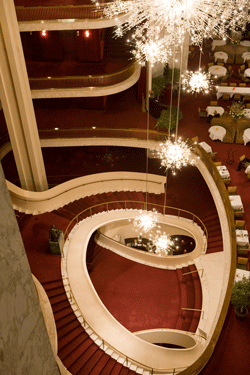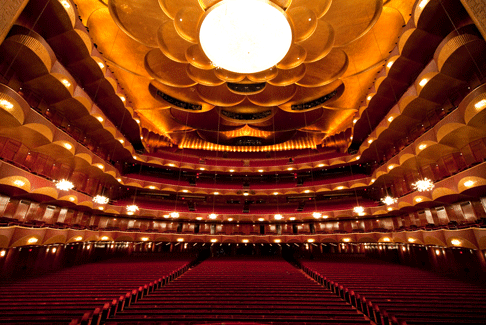The building’s first production was Faust in 1883 and the last
performance was La BohËme on April 16, 1966. Akin in style to the
prominent opera houses of Europe, many were understandingly upset about the destruction of this “landmark” building, in which Enrico Caruso, Ezio Pinza and many other great artists performed.
The “new” Met was dissimilar from the original. Architectural
plans were drawn in 1956, and groundbreaking began in 1961. Architect Wallace
K. Harrison, recognized for high-rise office buildings, was assigned to the
project. It needed to blend in with the surrounding structures slated to be a
world-class performing arts hub, designated as Lincoln Center.
Harrison opted for modernism in a low-rise complex totaling 97,700 sq. It
would contain an auditorium, a small hall, extensive lobby, private offices, as
well as a restaurant and gift shop.
 The lobby of the Metropolitan Opera House in New York City. [Photo: Marty Sohl/Metropolitan Opera]
The lobby of the Metropolitan Opera House in New York City. [Photo: Marty Sohl/Metropolitan Opera]
Much of the facade was composed of concrete and masonry work. The focal
point remains as five majestic arches resting on six “rectilinear”
concrete columns. Reaching 96 feet in height and 35 feet in width within
pre-cast shells, the striking curves in glass enhance the building’s front
exterior and inner lobby.
Two murals by Marc Chagall, The Triumph of Music and The
Sources of Music were commissioned for the Met to fill the immense open
space of the lobby. They are visible not only from within the premises, but can
be admired from the outside, near Lincoln Center’s fountain in the
courtyard.
An abundance of gleaming white marble, gold leafing and cascading crystal
chandeliers that illuminate a grand marble staircase in the foyer completed its
inner decor.
Rumor has it that the architect, Harrison, handed the crystal chandelier
designer, Hans Harald Rath, a book on the “Big Bang,” and requested
he should use it as inspiration for their design.
The stage is highly mechanized and the auditorium holds a total capacity of
3,995 (3800 seating, plus 195 standing room).
The final cost for the project was $46 million. The glittering results
became the perfect New York symbol for a night at the opera.
 The auditorium of the Metropolitan Opera House in New York City. [Photo: Jonathan Tichler/Metropolitan Opera]
The auditorium of the Metropolitan Opera House in New York City. [Photo: Jonathan Tichler/Metropolitan Opera]
September 16, 1966 was the opening night gala with Antony and
Cleopatra by composer Samuel Barber. Although reviewers found fault with
the production and appearance of the structure, one thing excelled that
couldn’t be ignored — the acoustics. Every note the orchestra played and the stars produce was heard with clarity, no matter where seated.
Opera greats, such as Pl·cido Domingo, Joan Sutherland, Marilyn Horne, and
more recently, Elīna Garanča and Vittorio Grigolo have graced
audiences clamoring “Bravo.”
Under the direction of James Levine, the 2012 season offers that much
desired Met repertoire favorites including Madam Butterfly,
Faust, Tosca, La Traviata and others. Lesser
known compositions, such as The Makropulos Case and The Enchanted Island complete a blend of a well-rounded season, running until May 12.
Afterwards, the celebrated opera company goes on hiatus. However, the
Metropolitan Opera House doesn’t remain dark. The American Ballet Theatre takes center stage, followed by various touring ballet companies before a new opera
season begins.
Tours are accessible all-year-round to explore the behind-the-scenes.
“Meet-the-Artist” is an innovative concept in which singers and
musicians answer questions from visitors.
Planning a Visit:
The Metropolitan Opera House
box office is situated in the lobby and tickets can be purchased
Monday–Saturday 10am–8pm, Sunday noon–6pm
The venue can easily be reached via public transportation.
By Subway: Take the number1 (7th Ave local train) to 66th Street/Lincoln
Center Station.
By Bus: The M5, M7, M10, M11, M66 and M104 bus lines all stop on 66th Street
and Broadway (one block away).
Find accommodations near the Met by visiting NewYorkHotels.org. Securing a hotel
near Central Park
(on the West Side) will be within walking distance to Lincoln Center.
Veronica Shine
The Metropolitan Opera is not responsible for the content of this
article.
image=http://www.operatoday.com/METOPERAHouse.gif
image_description=An exterior view of the Metropolitan Opera House in New York City [Photo: Marty Sohl/Metropolitan Opera]
product=yes
product_title=An Aria of Lincoln Center — The Metropolitan Opera House
product_by=By Veronica Shine
product_id=Above: An exterior view of the Metropolitan Opera House in New York City [Photo: Marty Sohl/Metropolitan Opera]
An Aria of Lincoln Center — The Metropolitan Opera
The building’s first production was Faust in 1883 and the last
performance was La BohËme on April 16, 1966. Akin in style to the
prominent opera houses of Europe, many were understandingly upset about the destruction of this “landmark” building, in which Enrico Caruso, Ezio Pinza and many other great artists performed.
The “new” Met was dissimilar from the original. Architectural
plans were drawn in 1956, and groundbreaking began in 1961. Architect Wallace
K. Harrison, recognized for high-rise office buildings, was assigned to the
project. It needed to blend in with the surrounding structures slated to be a
world-class performing arts hub, designated as Lincoln Center.
Harrison opted for modernism in a low-rise complex totaling 97,700 sq. It
would contain an auditorium, a small hall, extensive lobby, private offices, as
well as a restaurant and gift shop.
Much of the facade was composed of concrete and masonry work. The focal
point remains as five majestic arches resting on six “rectilinear”
concrete columns. Reaching 96 feet in height and 35 feet in width within
pre-cast shells, the striking curves in glass enhance the building’s front
exterior and inner lobby.
Two murals by Marc Chagall, The Triumph of Music and The
Sources of Music were commissioned for the Met to fill the immense open
space of the lobby. They are visible not only from within the premises, but can
be admired from the outside, near Lincoln Center’s fountain in the
courtyard.
An abundance of gleaming white marble, gold leafing and cascading crystal
chandeliers that illuminate a grand marble staircase in the foyer completed its
inner decor.
Rumor has it that the architect, Harrison, handed the crystal chandelier
designer, Hans Harald Rath, a book on the “Big Bang,” and requested
he should use it as inspiration for their design.
The stage is highly mechanized and the auditorium holds a total capacity of
3,995 (3800 seating, plus 195 standing room).
The final cost for the project was $46 million. The glittering results
became the perfect New York symbol for a night at the opera.
September 16, 1966 was the opening night gala with Antony and
Cleopatra by composer Samuel Barber. Although reviewers found fault with
the production and appearance of the structure, one thing excelled that
couldn’t be ignored — the acoustics. Every note the orchestra played and the stars produce was heard with clarity, no matter where seated.
Opera greats, such as Pl·cido Domingo, Joan Sutherland, Marilyn Horne, and
more recently, Elīna Garanča and Vittorio Grigolo have graced
audiences clamoring “Bravo.”
Under the direction of James Levine, the 2012 season offers that much
desired Met repertoire favorites including Madam Butterfly,
Faust, Tosca, La Traviata and others. Lesser
known compositions, such as The Makropulos Case and The Enchanted Island complete a blend of a well-rounded season, running until May 12.
Afterwards, the celebrated opera company goes on hiatus. However, the
Metropolitan Opera House doesn’t remain dark. The American Ballet Theatre takes center stage, followed by various touring ballet companies before a new opera
season begins.
Tours are accessible all-year-round to explore the behind-the-scenes.
“Meet-the-Artist” is an innovative concept in which singers and
musicians answer questions from visitors.
Planning a Visit:
The Metropolitan Opera House
box office is situated in the lobby and tickets can be purchased
Monday–Saturday 10am–8pm, Sunday noon–6pm
The venue can easily be reached via public transportation.
By Subway: Take the number1 (7th Ave local train) to 66th Street/Lincoln
Center Station.
By Bus: The M5, M7, M10, M11, M66 and M104 bus lines all stop on 66th Street
and Broadway (one block away).
Find accommodations near the Met by visiting NewYorkHotels.org. Securing a hotel
near Central Park
(on the West Side) will be within walking distance to Lincoln Center.
Veronica Shine
The Metropolitan Opera is not responsible for the content of this
article.
image=http://www.operatoday.com/METOPERAHouse.gif
image_description=An exterior view of the Metropolitan Opera House in New York City [Photo: Marty Sohl/Metropolitan Opera]
product=yes
product_title=An Aria of Lincoln Center — The Metropolitan Opera House
product_by=By Veronica Shine
product_id=Above: An exterior view of the Metropolitan Opera House in New York City [Photo: Marty Sohl/Metropolitan Opera]